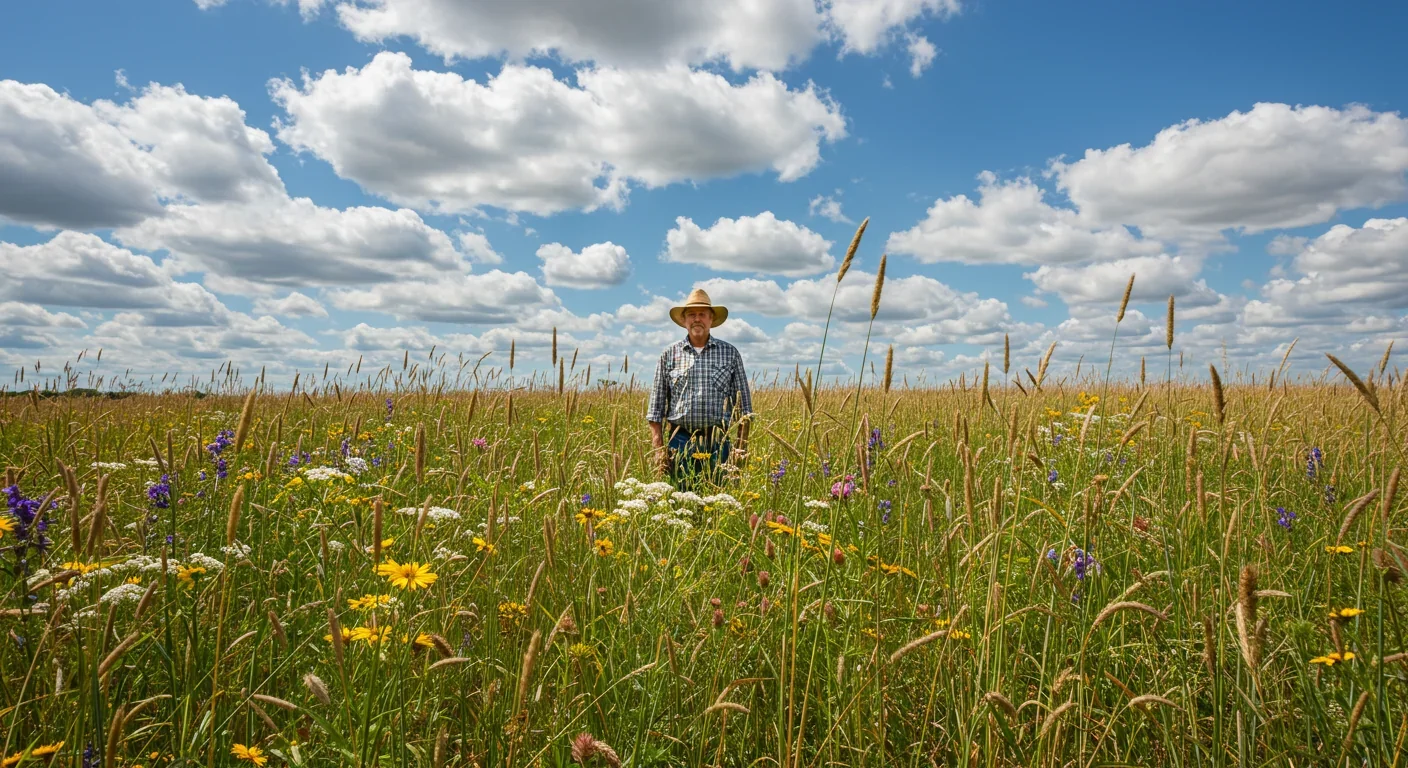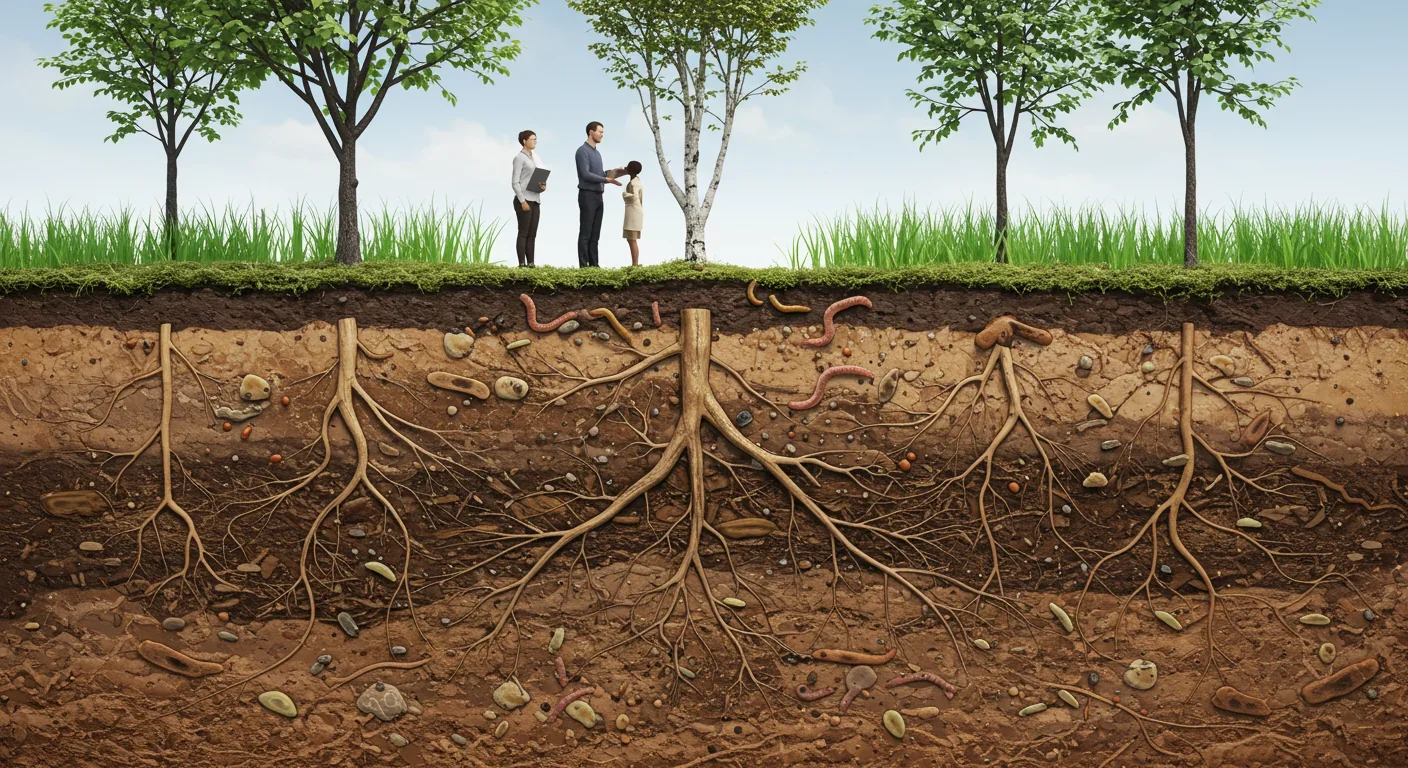Digital Pollution Tax: Can It Save Data Centers?

TL;DR: Farmers are revolutionizing agriculture by mimicking native prairies with perennial polyculture systems that produce food for decades without tilling or replanting. These self-sustaining ecosystems use 95% fewer chemicals, sequester 57% more carbon, and reduce erosion by 95% while maintaining competitive yields. As climate change intensifies, this prairie-inspired approach offers a proven blueprint for feeding humanity while regenerating the planet.

Imagine walking through a Kansas wheat field, but instead of seeing neat rows that need replanting every year, you're surrounded by a diverse tapestry of grains, legumes, and wildflowers that will produce food for the next 30 years without tilling, without replanting, and with 95% less chemical inputs. This isn't a fantasy—it's happening right now on farms across North America, where a quiet agricultural revolution is transforming how we grow food by mimicking the ecological genius of native prairies.
At The Land Institute in Kansas, scientists have cracked a code that nature wrote millions of years ago. By developing perennial grains like Kernza—a trademarked wheat relative with roots extending 14 feet deep—they've created crops that produce yields year after year while actually improving the soil beneath them. These aren't experimental plots hidden in research stations; twelve commercial growers are already harvesting Kernza across the northern United States, with three seed companies now licensed to distribute it.
The numbers tell a compelling story: perennial polyculture systems sequester up to 57% more carbon than conventional farms, reduce erosion by 95%, and maintain yields at 50-70% of annual wheat while requiring zero tillage after establishment. But here's what makes this truly revolutionary: unlike annual crops that treat soil as a mere growing medium, these prairie-inspired systems transform farmland into self-sustaining ecosystems that get more productive over time.
What researchers discovered goes against everything modern agriculture taught us. When you plant diverse perennial species together—mimicking the 40-60 grass species and 300+ flowering plants found in native prairies—something remarkable happens. The plants don't compete; they collaborate. Deep-rooted grains like Kernza pull water and minerals from depths annual wheat can't reach. Nitrogen-fixing legumes fertilize their neighbors naturally. Each species occupies its own ecological niche, creating what scientists call "overyielding"—where the whole produces more than the sum of its parts.
The genius of perennial polyculture lies in its architecture—both above and below ground. While annual wheat sends roots down maybe two feet, Kernza and other perennial grains drive roots three times deeper, some reaching 20 feet into the earth. These massive underground networks act as living carbon vaults, storing atmospheric CO2 in forms that remain stable for decades.
But the real magic happens in the interactions between species. In a typical perennial polyculture, you might find Kernza growing alongside Illinois bundleflower (a nitrogen-fixing legume with 38% protein content), eastern gamagrass (a drought-resistant prairie grass), and various wildflowers that attract beneficial insects. The bundleflower fixes up to 160 pounds of nitrogen per acre—equivalent to what farmers typically apply as synthetic fertilizer. The deep roots of different species create channels for water infiltration, increasing the soil's water-holding capacity by 22,000-40,000 liters per hectare annually.

This diversity creates its own pest management system. Research shows that polycultures with eight or more species host 73% more beneficial predator species than monocultures. These natural enemies keep pest populations in check without pesticides. When monarchs visit milkweed in these fields, they're 22% more likely to lay eggs than in monoculture plots, indicating healthier ecosystem dynamics.
The system essentially maintains itself. No annual tilling means soil structure remains intact, preserving the fungal networks that help plants share nutrients and information. No replanting means farmers save on seed, fuel, and labor costs every year after establishment. And because something is always growing and photosynthesizing, these fields capture solar energy year-round rather than lying fallow for months like conventional farms.
The shift to perennial polyculture represents the third great transformation in human agriculture. The first came 10,000 years ago when we learned to cultivate annual grains, trading the diverse perennial grasslands for simplified monocultures that required constant human intervention. The second arrived with mechanization and synthetic inputs in the 20th century, dramatically increasing yields but at enormous ecological cost.
Consider the Dust Bowl of the 1930s—a disaster that occurred precisely because farmers plowed up 100 million acres of deep-rooted prairie grasses to plant annual wheat. When drought hit, those shallow-rooted annuals couldn't hold the soil. Twenty tons of topsoil per acre blew away, creating black blizzards that reached Washington, D.C. As one Lakota elder observed at the time, settlers had turned the prairie "wrong side up."
Today's perennial revolution reverses that historic mistake. We're not abandoning technology but aligning it with ecological principles that prairies perfected over millennia. Just as the printing press democratized knowledge and the internet transformed communication, perennial polyculture could democratize agricultural resilience, making sustainable food production accessible to farmers worldwide.
History also shows us that agricultural transformations take time. The Green Revolution required decades of development, massive public investment, and coordinated international effort. The Land Institute, founded in 1976, has compressed thousands of years of natural selection into decades of intensive breeding. Their 2020 receipt of a $10 million USDA grant signals that perennial grains have moved from radical experiment to recognized solution.
The parallels to renewable energy adoption are striking. Just as solar panels started as expensive curiosities and became cheaper than fossil fuels, perennial grains began with 10% yields and now achieve 70% of conventional wheat. Both technologies faced skepticism from entrenched industries, required patient capital for development, and ultimately won by offering superior long-term economics alongside environmental benefits.
The benefits cascade through every level of the agricultural system. Economically, farmers see dramatic input reductions: no annual seed purchases after establishment, 95% less tilling means 95% less fuel use, and natural nitrogen fixation can eliminate fertilizer costs. EcoSun Prairie Farm in South Dakota achieved profitability by year three, with seed sales generating $160,000 annually by year six—a 60% gross margin improvement over conventional grain farming.
Kernza offers multiple revenue streams that conventional wheat can't match. The same field produces grain for human consumption (already being used in cereals, baked goods, and beer), forage for livestock between grain harvests, and continuous ground cover that qualifies for carbon credit programs. When grain yields are low in dry years, farmers can harvest the entire crop as high-protein animal feed, providing economic insurance against climate extremes.
The ecosystem services are equally valuable. Perennial root systems increase soil organic matter by 15% over five years, improving fertility and water retention. This enhanced soil structure means fields absorb heavy rainfall like sponges rather than letting it run off, reducing flooding downstream. During droughts, those deep roots access water that annual crops can't reach, maintaining yields when conventional fields fail.
Biodiversity flourishes in these systems. May Ranch documented 248 plant species after converting to prairie-based agriculture, including 50 types of grasses that support everything from grassland birds to pollinators. This biological richness provides resilience against pests, diseases, and weather extremes that devastate monocultures.
Carbon sequestration offers another revenue opportunity. Perennial systems store 1-2 megagrams of carbon per hectare annually in depths where it remains stable for decades. With carbon credit programs expanding globally, farmers can get paid for fighting climate change while producing food.
The transition isn't without challenges. Establishment requires patience—perennial polycultures take 2-3 years to reach full productivity, creating a cash flow gap that can strain farm finances. The upfront seed costs are higher than annuals, and farmers need different equipment for harvesting diverse crops at various heights and maturity times.
Knowledge barriers are significant. Managing polycultures requires understanding ecological interactions, not just following fertilizer schedules. Farmers must learn to read their fields differently, recognizing beneficial insects, understanding plant guilds, and timing harvests for multiple species. This complexity intimidates farmers accustomed to monoculture simplicity.
Market infrastructure remains underdeveloped. While demand for Kernza is growing, farmers need reliable buyers before committing acreage. Processing facilities for perennial grains are scarce, and most grain elevators aren't equipped to handle diverse crops. The University of Wyoming's economic analysis found that Kernza profitability depends entirely on securing market access before planting.
Yield gaps persist despite improvements. Even elite perennial wheat lines produce only 50-70% of annual wheat yields. For farmers operating on thin margins, that 30% reduction can mean the difference between profit and bankruptcy, especially if premium markets don't materialize.
Policy support lags behind technical development. Crop insurance doesn't cover perennial grains, leaving farmers exposed to establishment failures. Subsidies still favor annual commodity crops, making it financially risky to transition. Without policy reform, adoption will remain limited to early adopters and those with external funding.
The prairie model is spreading globally, adapted to local ecosystems and cultures. In China, researchers are developing perennial rice that eliminates labor-intensive annual transplanting while maintaining yields. Southeast Asian farmers report that perennial rice reduces labor by 60% while improving soil health—crucial for smallholders who can't afford machinery.
African initiatives take inspiration from traditional polycultures. The GIZ ProSoil program has helped farmers across six countries implement prairie-like systems on 816,000 hectares, increasing yields 30-50% while building drought resilience. These aren't Western imports but contemporary applications of indigenous knowledge that recognized diversity's value long before modern science.
European farmers are creating "cultivated prairies" that produce food while meeting strict biodiversity requirements. Dutch farmers intercrop perennial grains with wildflower strips, qualifying for environmental payments while maintaining productivity. This model shows how policy can accelerate adoption when ecological services are properly valued.
Brazil's integration of perennial systems into existing pasturelands demonstrates scalability. Farmers are establishing prairie-like polycultures between tree rows in agroforestry systems, creating three-dimensional production systems that mimic rainforest structure while producing grains, livestock, and timber.
The approach resonates differently across cultures. Indigenous communities see validation of traditional practices that colonialism dismissed as "primitive." Young farmers embrace it as high-tech ecology. Climate activists view it as practical action. This cultural flexibility suggests perennial polyculture isn't just another agricultural technique but a new paradigm for human-nature relationships.
The skills farmers need are evolving from mechanical to ecological. Tomorrow's successful farmers will think like ecosystem managers, understanding nutrient cycles, beneficial insects, and plant interactions. Agricultural education is already shifting—Kansas State University now offers courses in perennial grain systems, and online communities share polyculture management strategies globally.
Technology is accelerating adoption. Satellite monitoring helps farmers track the health of diverse plantings, AI-powered apps identify beneficial insects and diseases, and blockchain systems verify carbon sequestration for credit markets. These tools make complexity manageable, allowing farmers to orchestrate diversity rather than fight it.

Consumers can drive change through purchasing power. Products made with Kernza and other perennial grains are entering mainstream markets. Patagonia Provisions sells Kernza beer, and General Mills includes it in cereals. By choosing these products, consumers signal that they value agriculture that regenerates rather than depletes.
The transition requires reimagining agricultural success. Instead of measuring only yield per acre this year, we need metrics for soil health improvement, carbon sequestration, biodiversity support, and long-term resilience. Farmers who build ecological wealth alongside financial wealth will thrive as climate chaos intensifies and ecosystem services become increasingly valuable.
Within the next decade, perennial grains will likely achieve yield parity with annuals through continued breeding. When that happens—when prairie-inspired farms produce equal food with dramatically lower inputs and environmental benefits—the economic equation will flip entirely. Early adopters who've built knowledge and market relationships will have massive advantages.
The prairie farmers of tomorrow won't just grow food; they'll orchestrate ecosystems that produce multiple benefits for multiple stakeholders. They'll be carbon farmers, biodiversity stewards, water quality protectors, and food producers simultaneously. This isn't a return to the past but an evolution toward agriculture that works with nature's principles rather than against them. As climate change intensifies and resources become scarcer, these self-sustaining prairie farms offer a blueprint for feeding humanity while healing the planet.

Recent breakthroughs in fusion technology—including 351,000-gauss magnetic fields, AI-driven plasma diagnostics, and net energy gain at the National Ignition Facility—are transforming fusion propulsion from science fiction to engineering frontier. Scientists now have a realistic pathway to accelerate spacecraft to 10% of light speed, enabling a 43-year journey to Alpha Centauri. While challenges remain in miniaturization, neutron management, and sustained operation, the physics barriers have ...

Epigenetic clocks measure DNA methylation patterns to calculate biological age, which predicts disease risk up to 30 years before symptoms appear. Landmark studies show that accelerated epigenetic aging forecasts cardiovascular disease, diabetes, and neurodegeneration with remarkable accuracy. Lifestyle interventions—Mediterranean diet, structured exercise, quality sleep, stress management—can measurably reverse biological aging, reducing epigenetic age by 1-2 years within months. Commercial ...

Data centers consumed 415 terawatt-hours of electricity in 2024 and will nearly double that by 2030, driven by AI's insatiable energy appetite. Despite tech giants' renewable pledges, actual emissions are up to 662% higher than reported due to accounting loopholes. A digital pollution tax—similar to Europe's carbon border tariff—could finally force the industry to invest in efficiency technologies like liquid cooling, waste heat recovery, and time-matched renewable power, transforming volunta...

Humans are hardwired to see invisible agents—gods, ghosts, conspiracies—thanks to the Hyperactive Agency Detection Device (HADD), an evolutionary survival mechanism that favored false alarms over fatal misses. This cognitive bias, rooted in brain regions like the temporoparietal junction and medial prefrontal cortex, generates religious beliefs, animistic worldviews, and conspiracy theories across all cultures. Understanding HADD doesn't eliminate belief, but it helps us recognize when our pa...

The bombardier beetle has perfected a chemical defense system that human engineers are still trying to replicate: a two-chamber micro-combustion engine that mixes hydroquinone and hydrogen peroxide to create explosive 100°C sprays at up to 500 pulses per second, aimed with 270-degree precision. This tiny insect's biochemical marvel is inspiring revolutionary technologies in aerospace propulsion, pharmaceutical delivery, and fire suppression. By 2030, beetle-inspired systems could position sat...

The U.S. faces a catastrophic care worker shortage driven by poverty-level wages, overwhelming burnout, and systemic undervaluation. With 99% of nursing homes hiring and 9.7 million openings projected by 2034, the crisis threatens patient safety, family stability, and economic productivity. Evidence-based solutions—wage reforms, streamlined training, technology integration, and policy enforcement—exist and work, but require sustained political will and cultural recognition that caregiving is ...

Every major AI model was trained on copyrighted text scraped without permission, triggering billion-dollar lawsuits and forcing a reckoning between innovation and creator rights. The future depends on finding balance between transformative AI development and fair compensation for the people whose work fuels it.